Australia's GDP and Economic Growth: Analysis of Policies & Trends
VerifiedAdded on 2023/06/12
|16
|3861
|233
Essay
AI Summary
This essay examines Australia's GDP and economic growth over the past five years, highlighting the fluctuations and key influencing factors. It delves into the role of government policies, both demand-side (monetary and fiscal) and supply-side, in stimulating economic activity. The analysis covers the growth of specific industries like mining, agriculture, and aviation, attributing their success to factors such as government support and favorable global conditions. The essay concludes by emphasizing the importance of sustained policy efforts in maintaining Australia's economic prosperity.
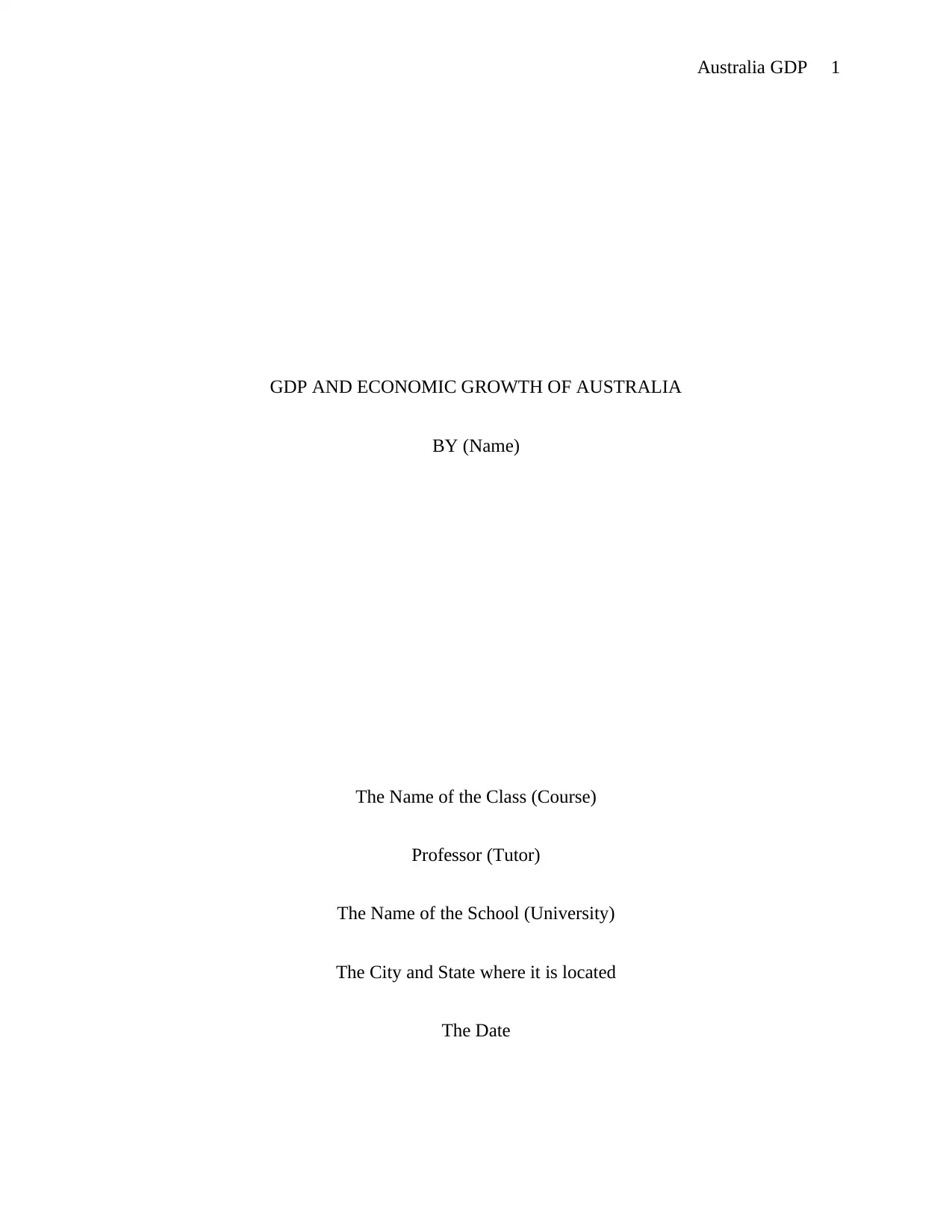
Australia GDP 1
GDP AND ECONOMIC GROWTH OF AUSTRALIA
BY (Name)
The Name of the Class (Course)
Professor (Tutor)
The Name of the School (University)
The City and State where it is located
The Date
GDP AND ECONOMIC GROWTH OF AUSTRALIA
BY (Name)
The Name of the Class (Course)
Professor (Tutor)
The Name of the School (University)
The City and State where it is located
The Date
Paraphrase This Document
Need a fresh take? Get an instant paraphrase of this document with our AI Paraphraser
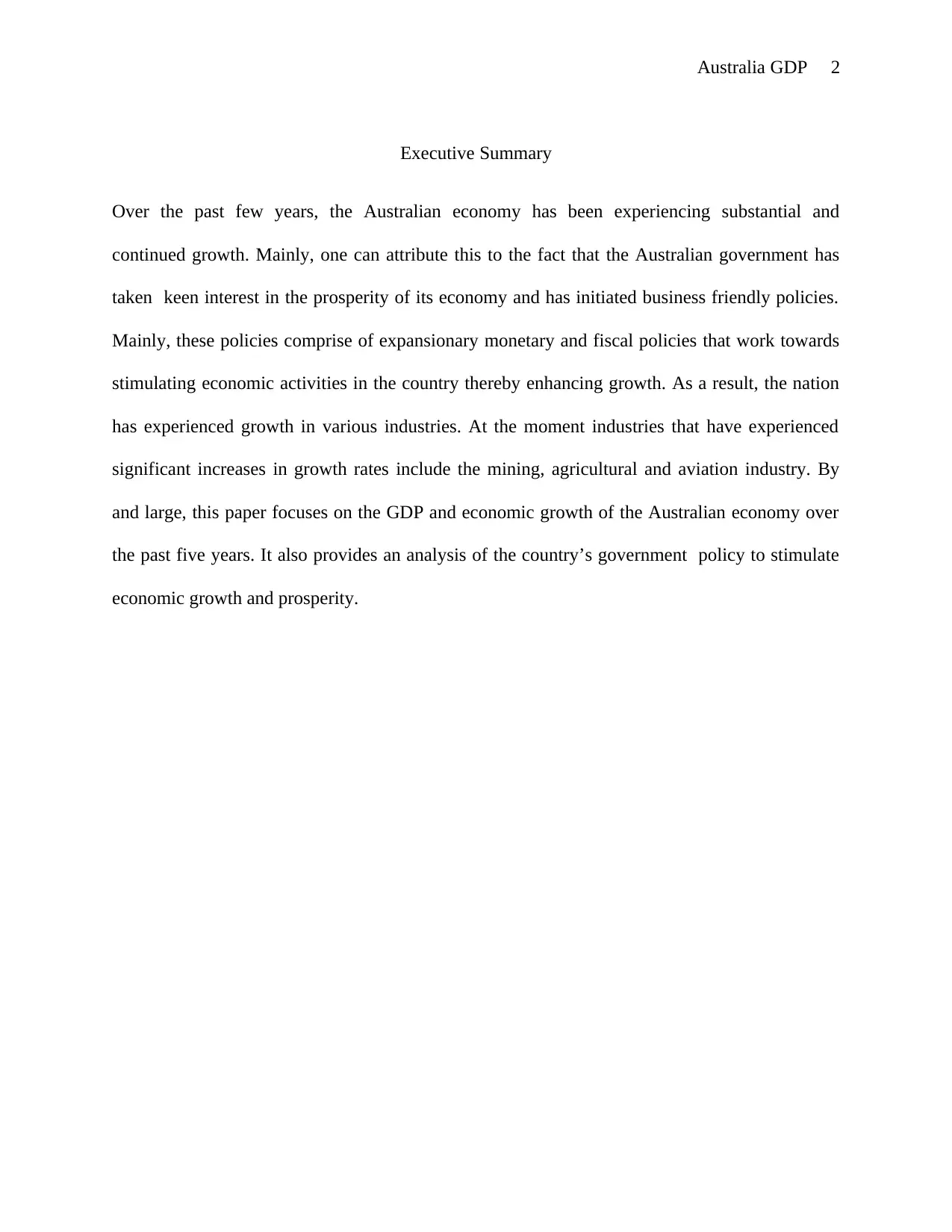
Australia GDP 2
Executive Summary
Over the past few years, the Australian economy has been experiencing substantial and
continued growth. Mainly, one can attribute this to the fact that the Australian government has
taken keen interest in the prosperity of its economy and has initiated business friendly policies.
Mainly, these policies comprise of expansionary monetary and fiscal policies that work towards
stimulating economic activities in the country thereby enhancing growth. As a result, the nation
has experienced growth in various industries. At the moment industries that have experienced
significant increases in growth rates include the mining, agricultural and aviation industry. By
and large, this paper focuses on the GDP and economic growth of the Australian economy over
the past five years. It also provides an analysis of the country’s government policy to stimulate
economic growth and prosperity.
Executive Summary
Over the past few years, the Australian economy has been experiencing substantial and
continued growth. Mainly, one can attribute this to the fact that the Australian government has
taken keen interest in the prosperity of its economy and has initiated business friendly policies.
Mainly, these policies comprise of expansionary monetary and fiscal policies that work towards
stimulating economic activities in the country thereby enhancing growth. As a result, the nation
has experienced growth in various industries. At the moment industries that have experienced
significant increases in growth rates include the mining, agricultural and aviation industry. By
and large, this paper focuses on the GDP and economic growth of the Australian economy over
the past five years. It also provides an analysis of the country’s government policy to stimulate
economic growth and prosperity.
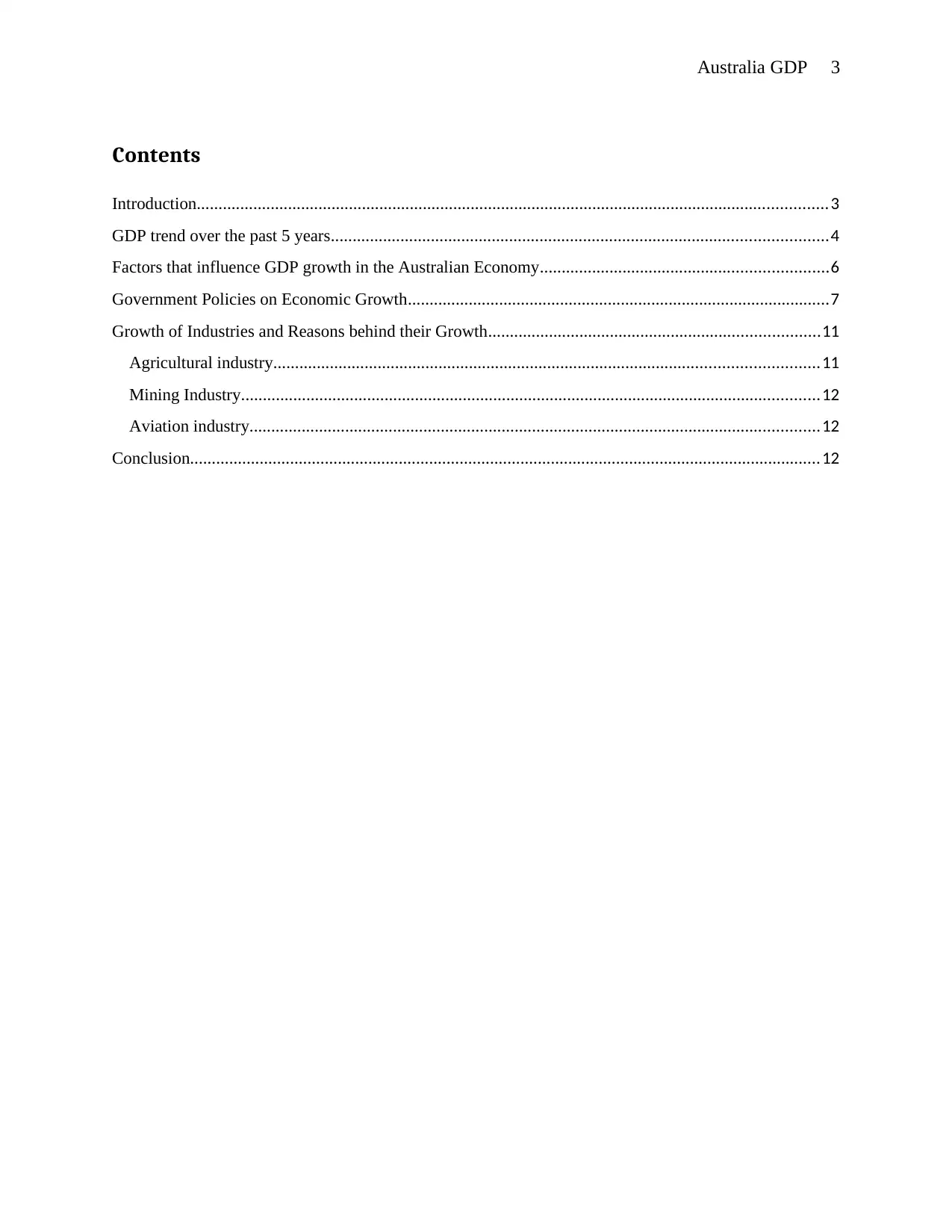
Australia GDP 3
Contents
Introduction.................................................................................................................................................3
GDP trend over the past 5 years..................................................................................................................4
Factors that influence GDP growth in the Australian Economy..................................................................6
Government Policies on Economic Growth.................................................................................................7
Growth of Industries and Reasons behind their Growth............................................................................11
Agricultural industry.............................................................................................................................11
Mining Industry.....................................................................................................................................12
Aviation industry...................................................................................................................................12
Conclusion.................................................................................................................................................12
Contents
Introduction.................................................................................................................................................3
GDP trend over the past 5 years..................................................................................................................4
Factors that influence GDP growth in the Australian Economy..................................................................6
Government Policies on Economic Growth.................................................................................................7
Growth of Industries and Reasons behind their Growth............................................................................11
Agricultural industry.............................................................................................................................11
Mining Industry.....................................................................................................................................12
Aviation industry...................................................................................................................................12
Conclusion.................................................................................................................................................12
⊘ This is a preview!⊘
Do you want full access?
Subscribe today to unlock all pages.

Trusted by 1+ million students worldwide
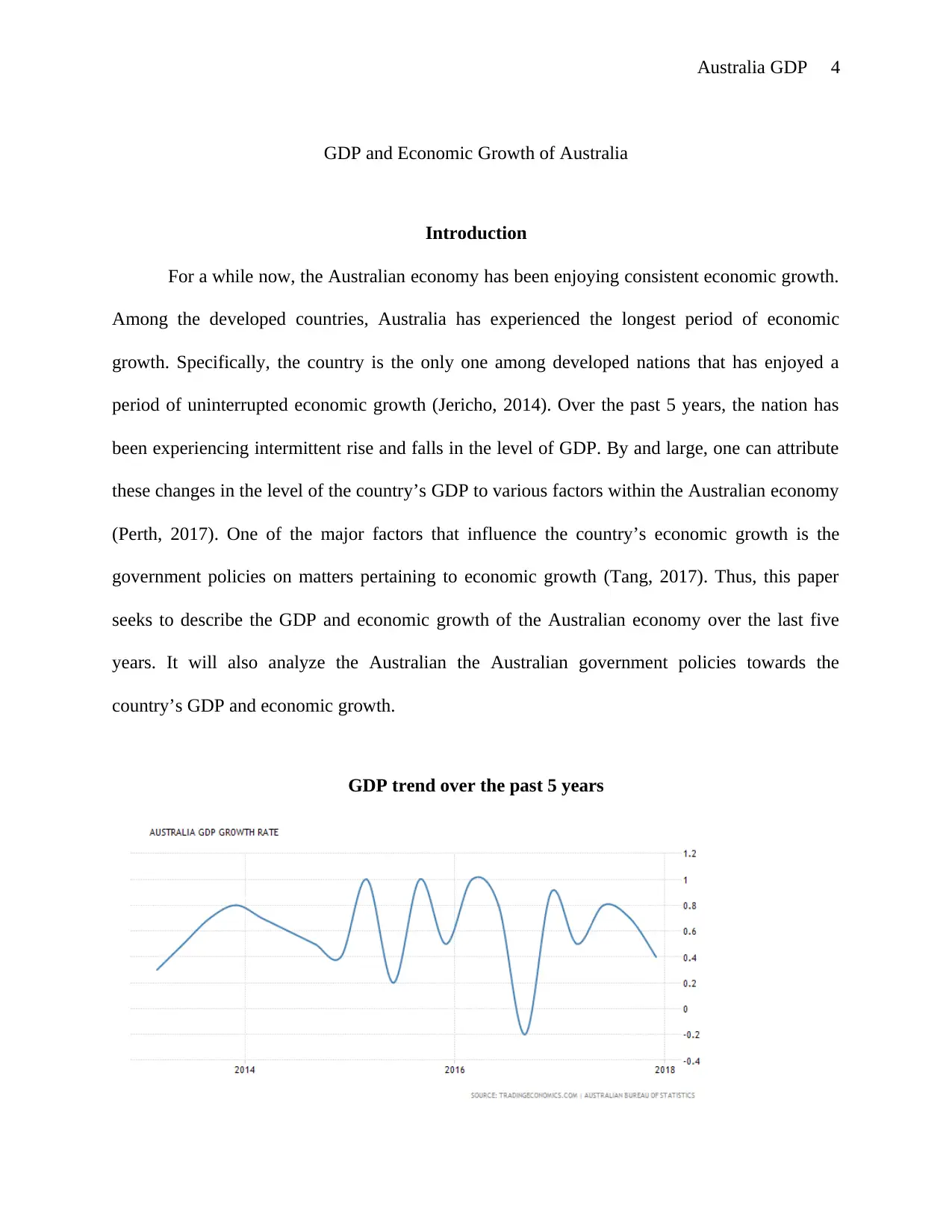
Australia GDP 4
GDP and Economic Growth of Australia
Introduction
For a while now, the Australian economy has been enjoying consistent economic growth.
Among the developed countries, Australia has experienced the longest period of economic
growth. Specifically, the country is the only one among developed nations that has enjoyed a
period of uninterrupted economic growth (Jericho, 2014). Over the past 5 years, the nation has
been experiencing intermittent rise and falls in the level of GDP. By and large, one can attribute
these changes in the level of the country’s GDP to various factors within the Australian economy
(Perth, 2017). One of the major factors that influence the country’s economic growth is the
government policies on matters pertaining to economic growth (Tang, 2017). Thus, this paper
seeks to describe the GDP and economic growth of the Australian economy over the last five
years. It will also analyze the Australian the Australian government policies towards the
country’s GDP and economic growth.
GDP trend over the past 5 years
GDP and Economic Growth of Australia
Introduction
For a while now, the Australian economy has been enjoying consistent economic growth.
Among the developed countries, Australia has experienced the longest period of economic
growth. Specifically, the country is the only one among developed nations that has enjoyed a
period of uninterrupted economic growth (Jericho, 2014). Over the past 5 years, the nation has
been experiencing intermittent rise and falls in the level of GDP. By and large, one can attribute
these changes in the level of the country’s GDP to various factors within the Australian economy
(Perth, 2017). One of the major factors that influence the country’s economic growth is the
government policies on matters pertaining to economic growth (Tang, 2017). Thus, this paper
seeks to describe the GDP and economic growth of the Australian economy over the last five
years. It will also analyze the Australian the Australian government policies towards the
country’s GDP and economic growth.
GDP trend over the past 5 years
Paraphrase This Document
Need a fresh take? Get an instant paraphrase of this document with our AI Paraphraser
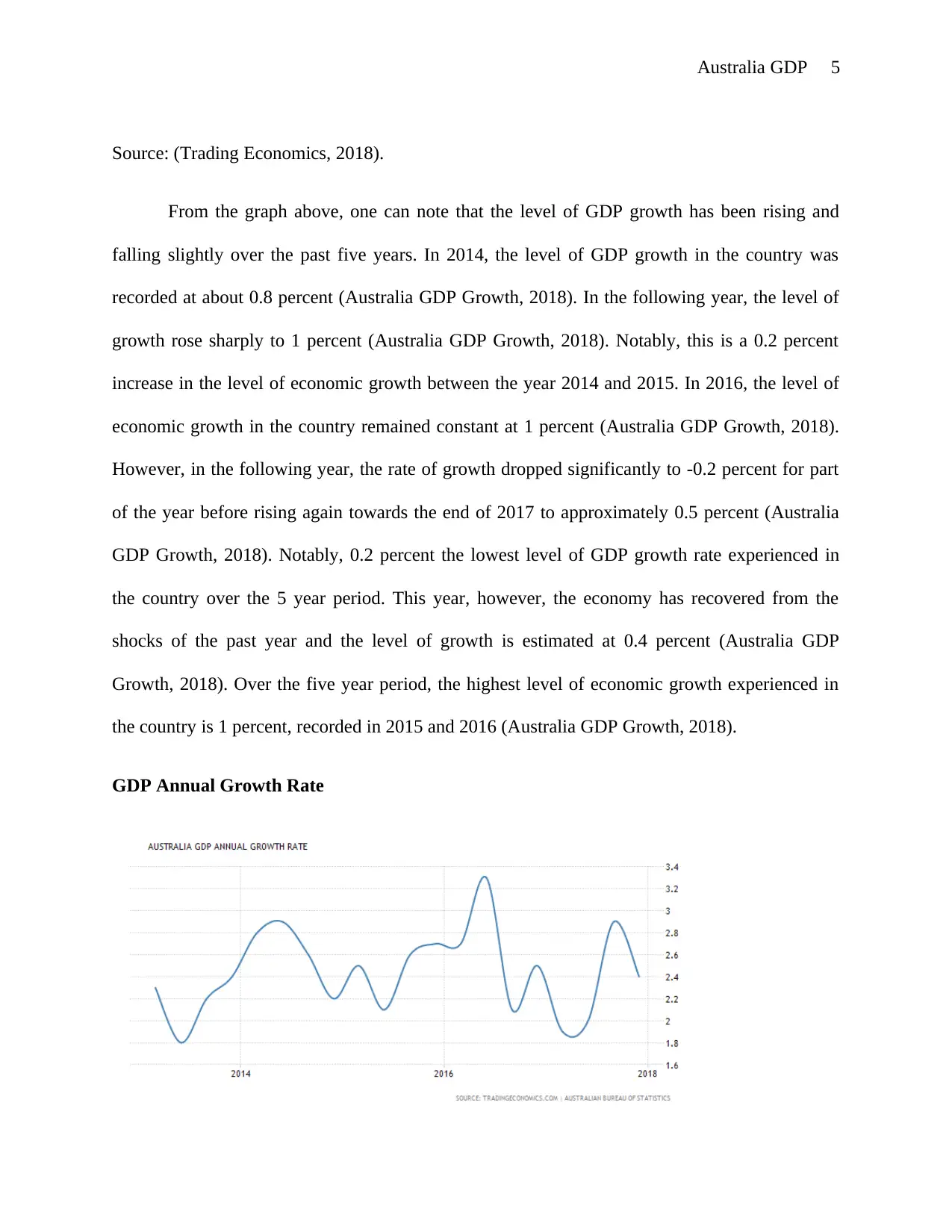
Australia GDP 5
Source: (Trading Economics, 2018).
From the graph above, one can note that the level of GDP growth has been rising and
falling slightly over the past five years. In 2014, the level of GDP growth in the country was
recorded at about 0.8 percent (Australia GDP Growth, 2018). In the following year, the level of
growth rose sharply to 1 percent (Australia GDP Growth, 2018). Notably, this is a 0.2 percent
increase in the level of economic growth between the year 2014 and 2015. In 2016, the level of
economic growth in the country remained constant at 1 percent (Australia GDP Growth, 2018).
However, in the following year, the rate of growth dropped significantly to -0.2 percent for part
of the year before rising again towards the end of 2017 to approximately 0.5 percent (Australia
GDP Growth, 2018). Notably, 0.2 percent the lowest level of GDP growth rate experienced in
the country over the 5 year period. This year, however, the economy has recovered from the
shocks of the past year and the level of growth is estimated at 0.4 percent (Australia GDP
Growth, 2018). Over the five year period, the highest level of economic growth experienced in
the country is 1 percent, recorded in 2015 and 2016 (Australia GDP Growth, 2018).
GDP Annual Growth Rate
Source: (Trading Economics, 2018).
From the graph above, one can note that the level of GDP growth has been rising and
falling slightly over the past five years. In 2014, the level of GDP growth in the country was
recorded at about 0.8 percent (Australia GDP Growth, 2018). In the following year, the level of
growth rose sharply to 1 percent (Australia GDP Growth, 2018). Notably, this is a 0.2 percent
increase in the level of economic growth between the year 2014 and 2015. In 2016, the level of
economic growth in the country remained constant at 1 percent (Australia GDP Growth, 2018).
However, in the following year, the rate of growth dropped significantly to -0.2 percent for part
of the year before rising again towards the end of 2017 to approximately 0.5 percent (Australia
GDP Growth, 2018). Notably, 0.2 percent the lowest level of GDP growth rate experienced in
the country over the 5 year period. This year, however, the economy has recovered from the
shocks of the past year and the level of growth is estimated at 0.4 percent (Australia GDP
Growth, 2018). Over the five year period, the highest level of economic growth experienced in
the country is 1 percent, recorded in 2015 and 2016 (Australia GDP Growth, 2018).
GDP Annual Growth Rate
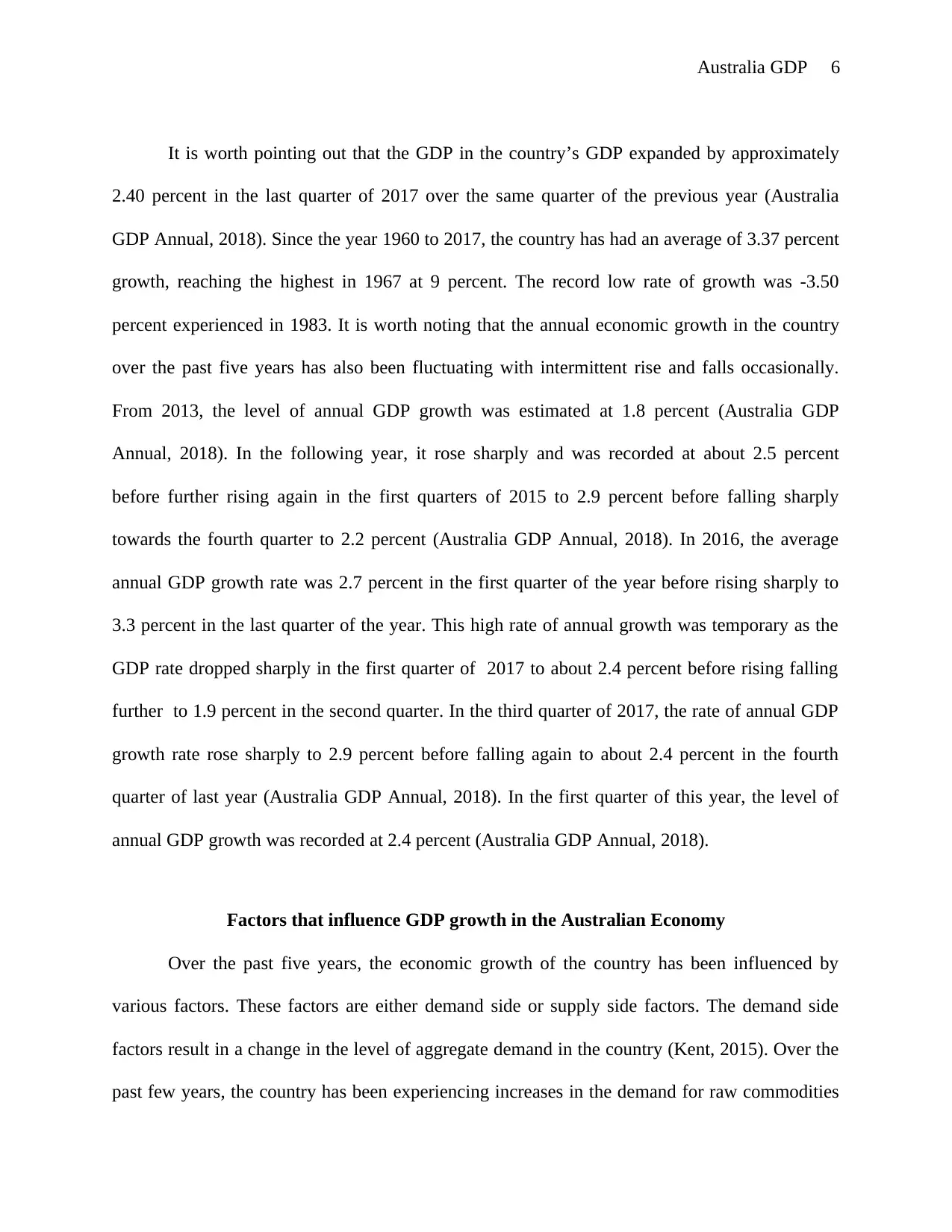
Australia GDP 6
It is worth pointing out that the GDP in the country’s GDP expanded by approximately
2.40 percent in the last quarter of 2017 over the same quarter of the previous year (Australia
GDP Annual, 2018). Since the year 1960 to 2017, the country has had an average of 3.37 percent
growth, reaching the highest in 1967 at 9 percent. The record low rate of growth was -3.50
percent experienced in 1983. It is worth noting that the annual economic growth in the country
over the past five years has also been fluctuating with intermittent rise and falls occasionally.
From 2013, the level of annual GDP growth was estimated at 1.8 percent (Australia GDP
Annual, 2018). In the following year, it rose sharply and was recorded at about 2.5 percent
before further rising again in the first quarters of 2015 to 2.9 percent before falling sharply
towards the fourth quarter to 2.2 percent (Australia GDP Annual, 2018). In 2016, the average
annual GDP growth rate was 2.7 percent in the first quarter of the year before rising sharply to
3.3 percent in the last quarter of the year. This high rate of annual growth was temporary as the
GDP rate dropped sharply in the first quarter of 2017 to about 2.4 percent before rising falling
further to 1.9 percent in the second quarter. In the third quarter of 2017, the rate of annual GDP
growth rate rose sharply to 2.9 percent before falling again to about 2.4 percent in the fourth
quarter of last year (Australia GDP Annual, 2018). In the first quarter of this year, the level of
annual GDP growth was recorded at 2.4 percent (Australia GDP Annual, 2018).
Factors that influence GDP growth in the Australian Economy
Over the past five years, the economic growth of the country has been influenced by
various factors. These factors are either demand side or supply side factors. The demand side
factors result in a change in the level of aggregate demand in the country (Kent, 2015). Over the
past few years, the country has been experiencing increases in the demand for raw commodities
It is worth pointing out that the GDP in the country’s GDP expanded by approximately
2.40 percent in the last quarter of 2017 over the same quarter of the previous year (Australia
GDP Annual, 2018). Since the year 1960 to 2017, the country has had an average of 3.37 percent
growth, reaching the highest in 1967 at 9 percent. The record low rate of growth was -3.50
percent experienced in 1983. It is worth noting that the annual economic growth in the country
over the past five years has also been fluctuating with intermittent rise and falls occasionally.
From 2013, the level of annual GDP growth was estimated at 1.8 percent (Australia GDP
Annual, 2018). In the following year, it rose sharply and was recorded at about 2.5 percent
before further rising again in the first quarters of 2015 to 2.9 percent before falling sharply
towards the fourth quarter to 2.2 percent (Australia GDP Annual, 2018). In 2016, the average
annual GDP growth rate was 2.7 percent in the first quarter of the year before rising sharply to
3.3 percent in the last quarter of the year. This high rate of annual growth was temporary as the
GDP rate dropped sharply in the first quarter of 2017 to about 2.4 percent before rising falling
further to 1.9 percent in the second quarter. In the third quarter of 2017, the rate of annual GDP
growth rate rose sharply to 2.9 percent before falling again to about 2.4 percent in the fourth
quarter of last year (Australia GDP Annual, 2018). In the first quarter of this year, the level of
annual GDP growth was recorded at 2.4 percent (Australia GDP Annual, 2018).
Factors that influence GDP growth in the Australian Economy
Over the past five years, the economic growth of the country has been influenced by
various factors. These factors are either demand side or supply side factors. The demand side
factors result in a change in the level of aggregate demand in the country (Kent, 2015). Over the
past few years, the country has been experiencing increases in the demand for raw commodities
⊘ This is a preview!⊘
Do you want full access?
Subscribe today to unlock all pages.

Trusted by 1+ million students worldwide
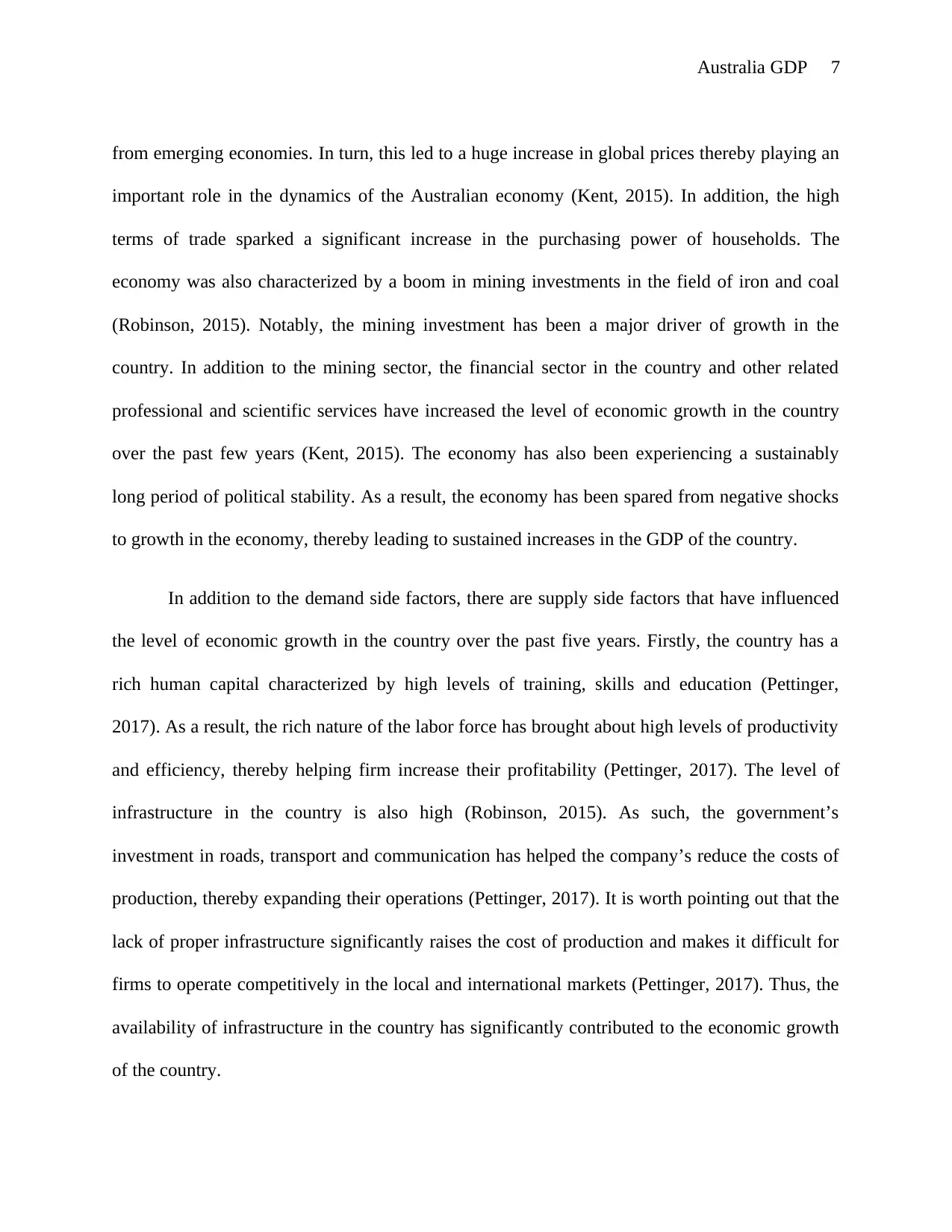
Australia GDP 7
from emerging economies. In turn, this led to a huge increase in global prices thereby playing an
important role in the dynamics of the Australian economy (Kent, 2015). In addition, the high
terms of trade sparked a significant increase in the purchasing power of households. The
economy was also characterized by a boom in mining investments in the field of iron and coal
(Robinson, 2015). Notably, the mining investment has been a major driver of growth in the
country. In addition to the mining sector, the financial sector in the country and other related
professional and scientific services have increased the level of economic growth in the country
over the past few years (Kent, 2015). The economy has also been experiencing a sustainably
long period of political stability. As a result, the economy has been spared from negative shocks
to growth in the economy, thereby leading to sustained increases in the GDP of the country.
In addition to the demand side factors, there are supply side factors that have influenced
the level of economic growth in the country over the past five years. Firstly, the country has a
rich human capital characterized by high levels of training, skills and education (Pettinger,
2017). As a result, the rich nature of the labor force has brought about high levels of productivity
and efficiency, thereby helping firm increase their profitability (Pettinger, 2017). The level of
infrastructure in the country is also high (Robinson, 2015). As such, the government’s
investment in roads, transport and communication has helped the company’s reduce the costs of
production, thereby expanding their operations (Pettinger, 2017). It is worth pointing out that the
lack of proper infrastructure significantly raises the cost of production and makes it difficult for
firms to operate competitively in the local and international markets (Pettinger, 2017). Thus, the
availability of infrastructure in the country has significantly contributed to the economic growth
of the country.
from emerging economies. In turn, this led to a huge increase in global prices thereby playing an
important role in the dynamics of the Australian economy (Kent, 2015). In addition, the high
terms of trade sparked a significant increase in the purchasing power of households. The
economy was also characterized by a boom in mining investments in the field of iron and coal
(Robinson, 2015). Notably, the mining investment has been a major driver of growth in the
country. In addition to the mining sector, the financial sector in the country and other related
professional and scientific services have increased the level of economic growth in the country
over the past few years (Kent, 2015). The economy has also been experiencing a sustainably
long period of political stability. As a result, the economy has been spared from negative shocks
to growth in the economy, thereby leading to sustained increases in the GDP of the country.
In addition to the demand side factors, there are supply side factors that have influenced
the level of economic growth in the country over the past five years. Firstly, the country has a
rich human capital characterized by high levels of training, skills and education (Pettinger,
2017). As a result, the rich nature of the labor force has brought about high levels of productivity
and efficiency, thereby helping firm increase their profitability (Pettinger, 2017). The level of
infrastructure in the country is also high (Robinson, 2015). As such, the government’s
investment in roads, transport and communication has helped the company’s reduce the costs of
production, thereby expanding their operations (Pettinger, 2017). It is worth pointing out that the
lack of proper infrastructure significantly raises the cost of production and makes it difficult for
firms to operate competitively in the local and international markets (Pettinger, 2017). Thus, the
availability of infrastructure in the country has significantly contributed to the economic growth
of the country.
Paraphrase This Document
Need a fresh take? Get an instant paraphrase of this document with our AI Paraphraser
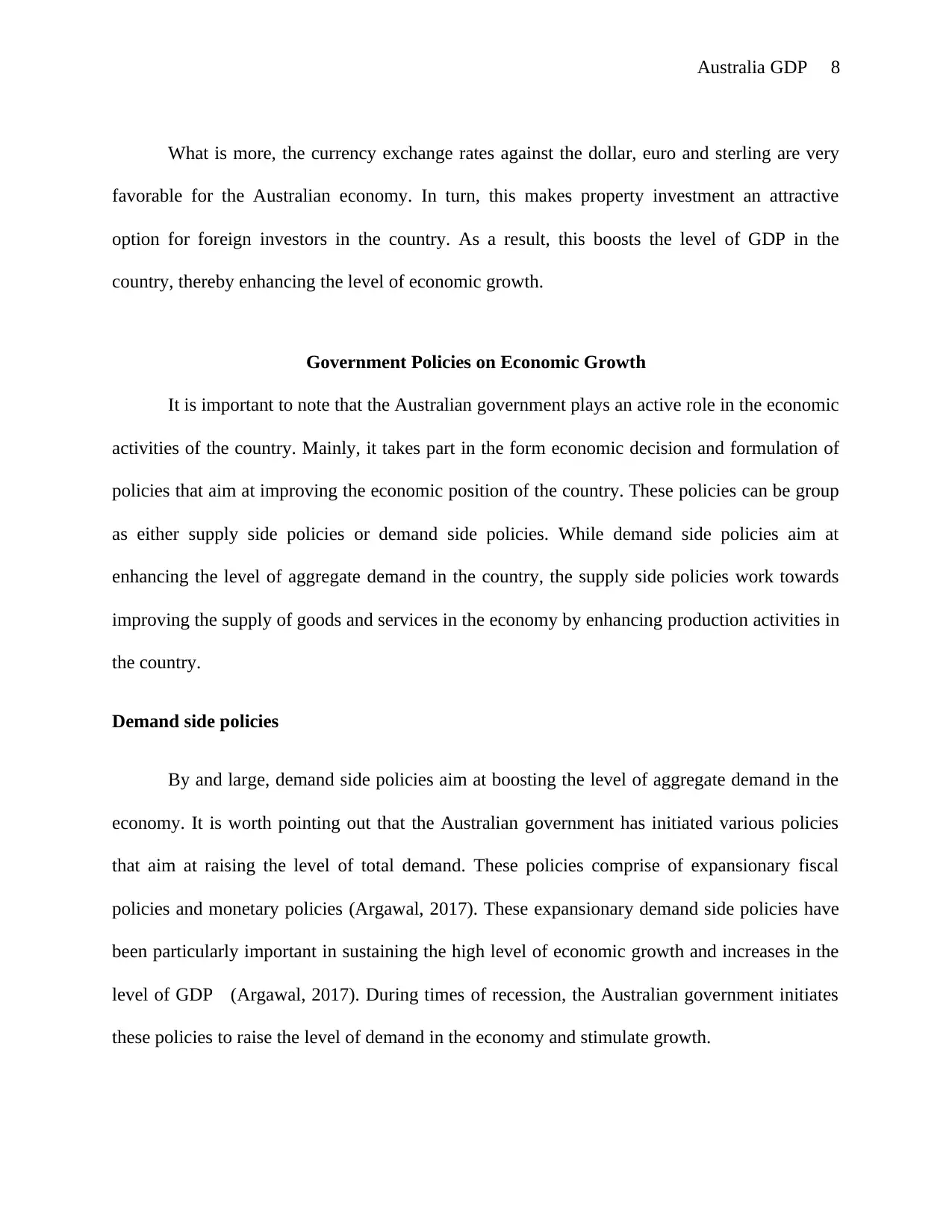
Australia GDP 8
What is more, the currency exchange rates against the dollar, euro and sterling are very
favorable for the Australian economy. In turn, this makes property investment an attractive
option for foreign investors in the country. As a result, this boosts the level of GDP in the
country, thereby enhancing the level of economic growth.
Government Policies on Economic Growth
It is important to note that the Australian government plays an active role in the economic
activities of the country. Mainly, it takes part in the form economic decision and formulation of
policies that aim at improving the economic position of the country. These policies can be group
as either supply side policies or demand side policies. While demand side policies aim at
enhancing the level of aggregate demand in the country, the supply side policies work towards
improving the supply of goods and services in the economy by enhancing production activities in
the country.
Demand side policies
By and large, demand side policies aim at boosting the level of aggregate demand in the
economy. It is worth pointing out that the Australian government has initiated various policies
that aim at raising the level of total demand. These policies comprise of expansionary fiscal
policies and monetary policies (Argawal, 2017). These expansionary demand side policies have
been particularly important in sustaining the high level of economic growth and increases in the
level of GDP (Argawal, 2017). During times of recession, the Australian government initiates
these policies to raise the level of demand in the economy and stimulate growth.
What is more, the currency exchange rates against the dollar, euro and sterling are very
favorable for the Australian economy. In turn, this makes property investment an attractive
option for foreign investors in the country. As a result, this boosts the level of GDP in the
country, thereby enhancing the level of economic growth.
Government Policies on Economic Growth
It is important to note that the Australian government plays an active role in the economic
activities of the country. Mainly, it takes part in the form economic decision and formulation of
policies that aim at improving the economic position of the country. These policies can be group
as either supply side policies or demand side policies. While demand side policies aim at
enhancing the level of aggregate demand in the country, the supply side policies work towards
improving the supply of goods and services in the economy by enhancing production activities in
the country.
Demand side policies
By and large, demand side policies aim at boosting the level of aggregate demand in the
economy. It is worth pointing out that the Australian government has initiated various policies
that aim at raising the level of total demand. These policies comprise of expansionary fiscal
policies and monetary policies (Argawal, 2017). These expansionary demand side policies have
been particularly important in sustaining the high level of economic growth and increases in the
level of GDP (Argawal, 2017). During times of recession, the Australian government initiates
these policies to raise the level of demand in the economy and stimulate growth.
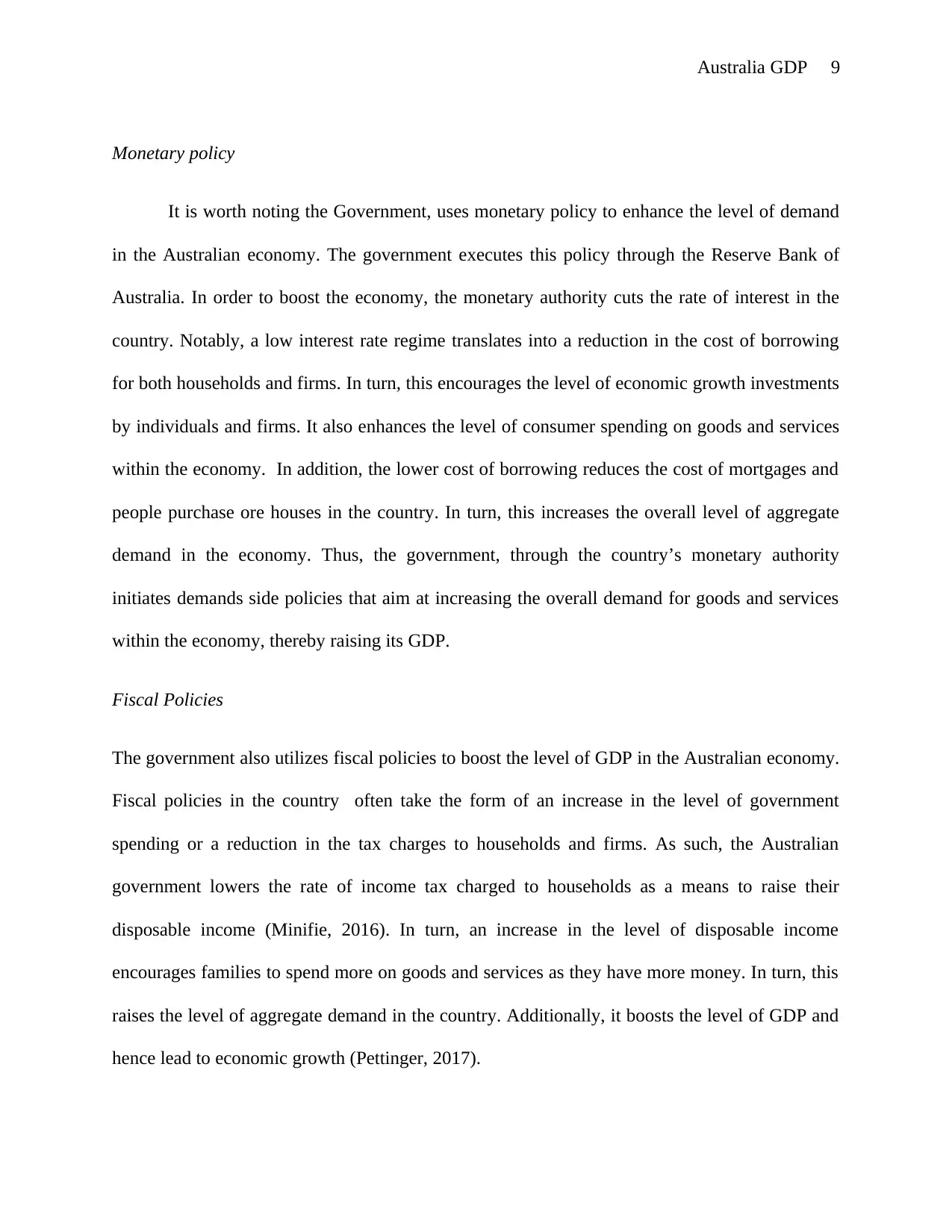
Australia GDP 9
Monetary policy
It is worth noting the Government, uses monetary policy to enhance the level of demand
in the Australian economy. The government executes this policy through the Reserve Bank of
Australia. In order to boost the economy, the monetary authority cuts the rate of interest in the
country. Notably, a low interest rate regime translates into a reduction in the cost of borrowing
for both households and firms. In turn, this encourages the level of economic growth investments
by individuals and firms. It also enhances the level of consumer spending on goods and services
within the economy. In addition, the lower cost of borrowing reduces the cost of mortgages and
people purchase ore houses in the country. In turn, this increases the overall level of aggregate
demand in the economy. Thus, the government, through the country’s monetary authority
initiates demands side policies that aim at increasing the overall demand for goods and services
within the economy, thereby raising its GDP.
Fiscal Policies
The government also utilizes fiscal policies to boost the level of GDP in the Australian economy.
Fiscal policies in the country often take the form of an increase in the level of government
spending or a reduction in the tax charges to households and firms. As such, the Australian
government lowers the rate of income tax charged to households as a means to raise their
disposable income (Minifie, 2016). In turn, an increase in the level of disposable income
encourages families to spend more on goods and services as they have more money. In turn, this
raises the level of aggregate demand in the country. Additionally, it boosts the level of GDP and
hence lead to economic growth (Pettinger, 2017).
Monetary policy
It is worth noting the Government, uses monetary policy to enhance the level of demand
in the Australian economy. The government executes this policy through the Reserve Bank of
Australia. In order to boost the economy, the monetary authority cuts the rate of interest in the
country. Notably, a low interest rate regime translates into a reduction in the cost of borrowing
for both households and firms. In turn, this encourages the level of economic growth investments
by individuals and firms. It also enhances the level of consumer spending on goods and services
within the economy. In addition, the lower cost of borrowing reduces the cost of mortgages and
people purchase ore houses in the country. In turn, this increases the overall level of aggregate
demand in the economy. Thus, the government, through the country’s monetary authority
initiates demands side policies that aim at increasing the overall demand for goods and services
within the economy, thereby raising its GDP.
Fiscal Policies
The government also utilizes fiscal policies to boost the level of GDP in the Australian economy.
Fiscal policies in the country often take the form of an increase in the level of government
spending or a reduction in the tax charges to households and firms. As such, the Australian
government lowers the rate of income tax charged to households as a means to raise their
disposable income (Minifie, 2016). In turn, an increase in the level of disposable income
encourages families to spend more on goods and services as they have more money. In turn, this
raises the level of aggregate demand in the country. Additionally, it boosts the level of GDP and
hence lead to economic growth (Pettinger, 2017).
⊘ This is a preview!⊘
Do you want full access?
Subscribe today to unlock all pages.

Trusted by 1+ million students worldwide
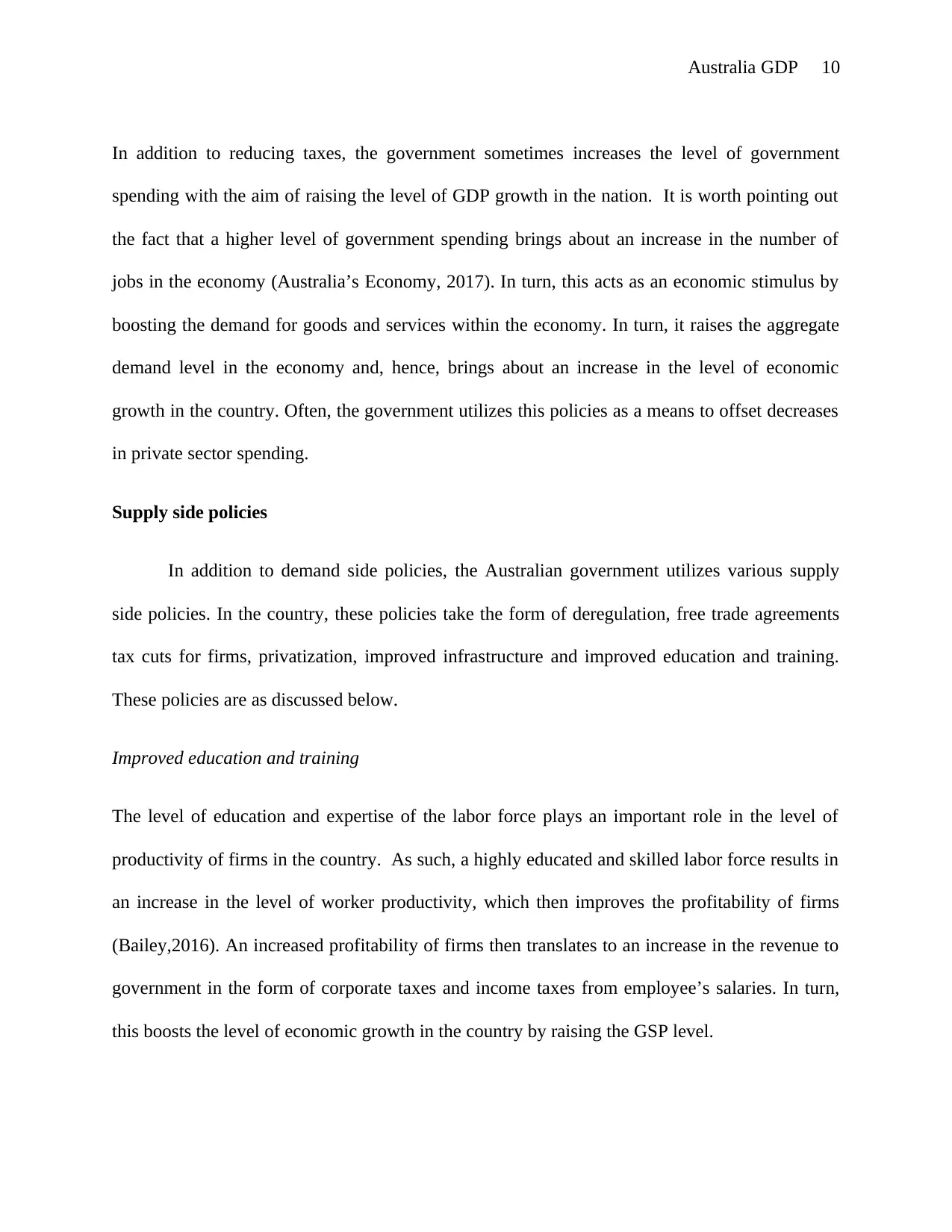
Australia GDP 10
In addition to reducing taxes, the government sometimes increases the level of government
spending with the aim of raising the level of GDP growth in the nation. It is worth pointing out
the fact that a higher level of government spending brings about an increase in the number of
jobs in the economy (Australia’s Economy, 2017). In turn, this acts as an economic stimulus by
boosting the demand for goods and services within the economy. In turn, it raises the aggregate
demand level in the economy and, hence, brings about an increase in the level of economic
growth in the country. Often, the government utilizes this policies as a means to offset decreases
in private sector spending.
Supply side policies
In addition to demand side policies, the Australian government utilizes various supply
side policies. In the country, these policies take the form of deregulation, free trade agreements
tax cuts for firms, privatization, improved infrastructure and improved education and training.
These policies are as discussed below.
Improved education and training
The level of education and expertise of the labor force plays an important role in the level of
productivity of firms in the country. As such, a highly educated and skilled labor force results in
an increase in the level of worker productivity, which then improves the profitability of firms
(Bailey,2016). An increased profitability of firms then translates to an increase in the revenue to
government in the form of corporate taxes and income taxes from employee’s salaries. In turn,
this boosts the level of economic growth in the country by raising the GSP level.
In addition to reducing taxes, the government sometimes increases the level of government
spending with the aim of raising the level of GDP growth in the nation. It is worth pointing out
the fact that a higher level of government spending brings about an increase in the number of
jobs in the economy (Australia’s Economy, 2017). In turn, this acts as an economic stimulus by
boosting the demand for goods and services within the economy. In turn, it raises the aggregate
demand level in the economy and, hence, brings about an increase in the level of economic
growth in the country. Often, the government utilizes this policies as a means to offset decreases
in private sector spending.
Supply side policies
In addition to demand side policies, the Australian government utilizes various supply
side policies. In the country, these policies take the form of deregulation, free trade agreements
tax cuts for firms, privatization, improved infrastructure and improved education and training.
These policies are as discussed below.
Improved education and training
The level of education and expertise of the labor force plays an important role in the level of
productivity of firms in the country. As such, a highly educated and skilled labor force results in
an increase in the level of worker productivity, which then improves the profitability of firms
(Bailey,2016). An increased profitability of firms then translates to an increase in the revenue to
government in the form of corporate taxes and income taxes from employee’s salaries. In turn,
this boosts the level of economic growth in the country by raising the GSP level.
Paraphrase This Document
Need a fresh take? Get an instant paraphrase of this document with our AI Paraphraser
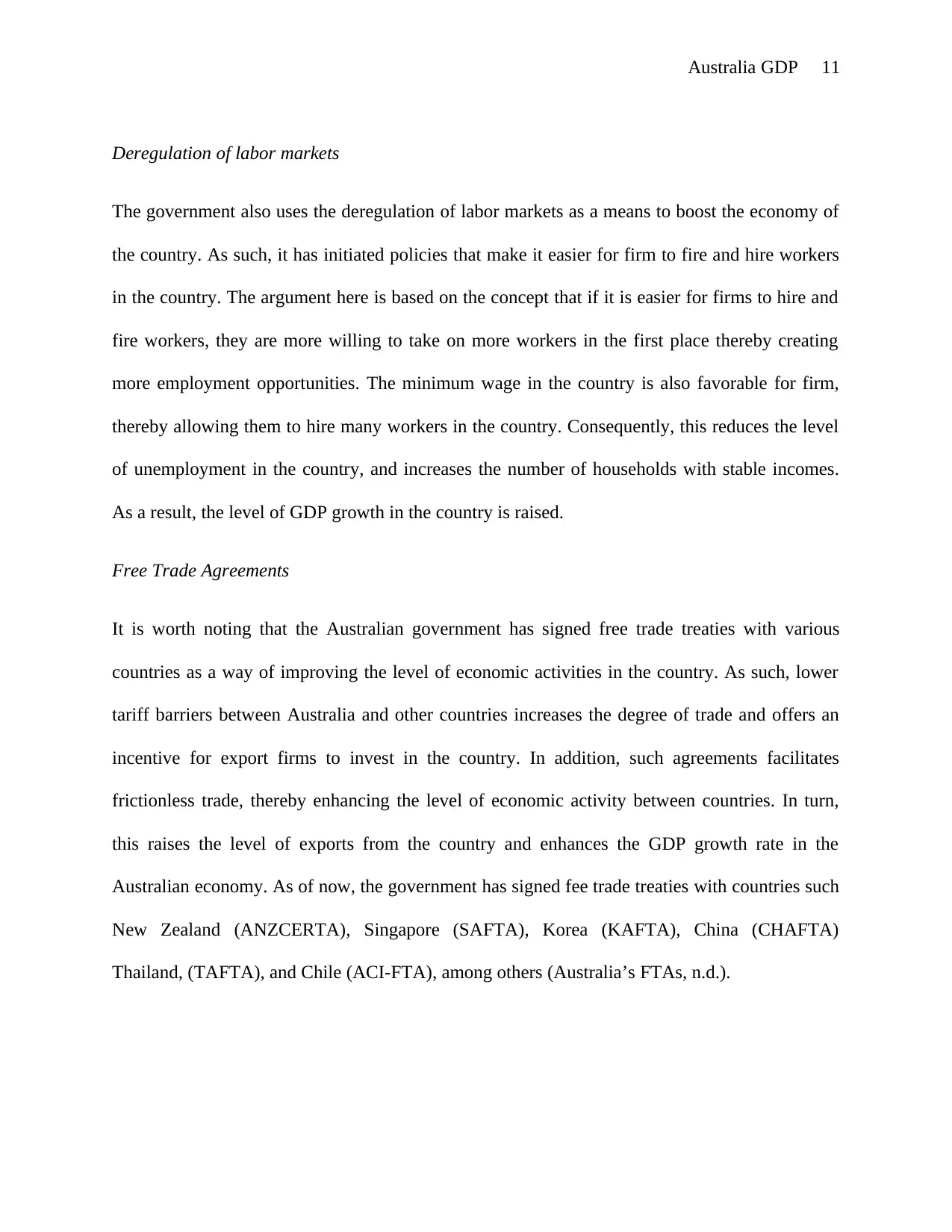
Australia GDP 11
Deregulation of labor markets
The government also uses the deregulation of labor markets as a means to boost the economy of
the country. As such, it has initiated policies that make it easier for firm to fire and hire workers
in the country. The argument here is based on the concept that if it is easier for firms to hire and
fire workers, they are more willing to take on more workers in the first place thereby creating
more employment opportunities. The minimum wage in the country is also favorable for firm,
thereby allowing them to hire many workers in the country. Consequently, this reduces the level
of unemployment in the country, and increases the number of households with stable incomes.
As a result, the level of GDP growth in the country is raised.
Free Trade Agreements
It is worth noting that the Australian government has signed free trade treaties with various
countries as a way of improving the level of economic activities in the country. As such, lower
tariff barriers between Australia and other countries increases the degree of trade and offers an
incentive for export firms to invest in the country. In addition, such agreements facilitates
frictionless trade, thereby enhancing the level of economic activity between countries. In turn,
this raises the level of exports from the country and enhances the GDP growth rate in the
Australian economy. As of now, the government has signed fee trade treaties with countries such
New Zealand (ANZCERTA), Singapore (SAFTA), Korea (KAFTA), China (CHAFTA)
Thailand, (TAFTA), and Chile (ACI-FTA), among others (Australia’s FTAs, n.d.).
Deregulation of labor markets
The government also uses the deregulation of labor markets as a means to boost the economy of
the country. As such, it has initiated policies that make it easier for firm to fire and hire workers
in the country. The argument here is based on the concept that if it is easier for firms to hire and
fire workers, they are more willing to take on more workers in the first place thereby creating
more employment opportunities. The minimum wage in the country is also favorable for firm,
thereby allowing them to hire many workers in the country. Consequently, this reduces the level
of unemployment in the country, and increases the number of households with stable incomes.
As a result, the level of GDP growth in the country is raised.
Free Trade Agreements
It is worth noting that the Australian government has signed free trade treaties with various
countries as a way of improving the level of economic activities in the country. As such, lower
tariff barriers between Australia and other countries increases the degree of trade and offers an
incentive for export firms to invest in the country. In addition, such agreements facilitates
frictionless trade, thereby enhancing the level of economic activity between countries. In turn,
this raises the level of exports from the country and enhances the GDP growth rate in the
Australian economy. As of now, the government has signed fee trade treaties with countries such
New Zealand (ANZCERTA), Singapore (SAFTA), Korea (KAFTA), China (CHAFTA)
Thailand, (TAFTA), and Chile (ACI-FTA), among others (Australia’s FTAs, n.d.).
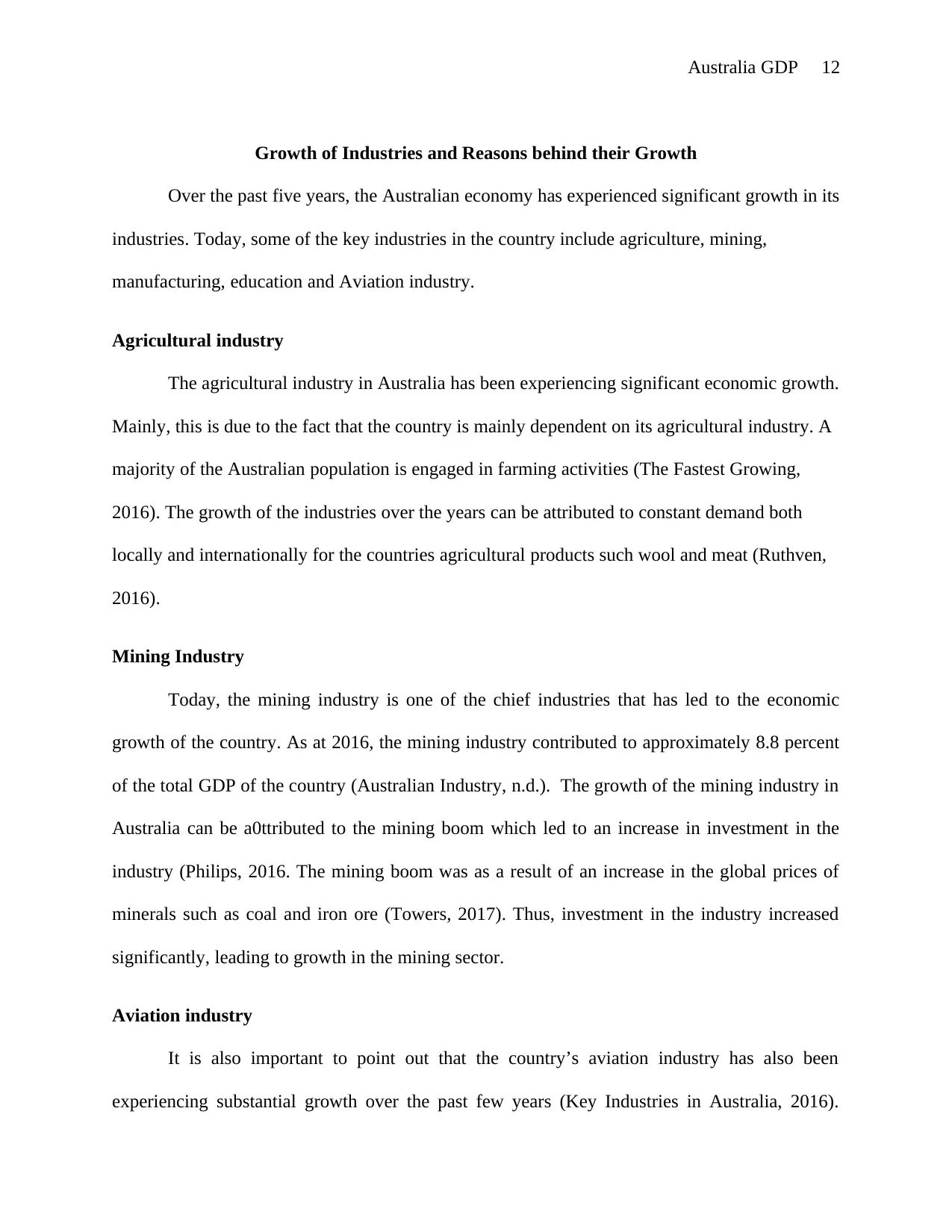
Australia GDP 12
Growth of Industries and Reasons behind their Growth
Over the past five years, the Australian economy has experienced significant growth in its
industries. Today, some of the key industries in the country include agriculture, mining,
manufacturing, education and Aviation industry.
Agricultural industry
The agricultural industry in Australia has been experiencing significant economic growth.
Mainly, this is due to the fact that the country is mainly dependent on its agricultural industry. A
majority of the Australian population is engaged in farming activities (The Fastest Growing,
2016). The growth of the industries over the years can be attributed to constant demand both
locally and internationally for the countries agricultural products such wool and meat (Ruthven,
2016).
Mining Industry
Today, the mining industry is one of the chief industries that has led to the economic
growth of the country. As at 2016, the mining industry contributed to approximately 8.8 percent
of the total GDP of the country (Australian Industry, n.d.). The growth of the mining industry in
Australia can be a0ttributed to the mining boom which led to an increase in investment in the
industry (Philips, 2016. The mining boom was as a result of an increase in the global prices of
minerals such as coal and iron ore (Towers, 2017). Thus, investment in the industry increased
significantly, leading to growth in the mining sector.
Aviation industry
It is also important to point out that the country’s aviation industry has also been
experiencing substantial growth over the past few years (Key Industries in Australia, 2016).
Growth of Industries and Reasons behind their Growth
Over the past five years, the Australian economy has experienced significant growth in its
industries. Today, some of the key industries in the country include agriculture, mining,
manufacturing, education and Aviation industry.
Agricultural industry
The agricultural industry in Australia has been experiencing significant economic growth.
Mainly, this is due to the fact that the country is mainly dependent on its agricultural industry. A
majority of the Australian population is engaged in farming activities (The Fastest Growing,
2016). The growth of the industries over the years can be attributed to constant demand both
locally and internationally for the countries agricultural products such wool and meat (Ruthven,
2016).
Mining Industry
Today, the mining industry is one of the chief industries that has led to the economic
growth of the country. As at 2016, the mining industry contributed to approximately 8.8 percent
of the total GDP of the country (Australian Industry, n.d.). The growth of the mining industry in
Australia can be a0ttributed to the mining boom which led to an increase in investment in the
industry (Philips, 2016. The mining boom was as a result of an increase in the global prices of
minerals such as coal and iron ore (Towers, 2017). Thus, investment in the industry increased
significantly, leading to growth in the mining sector.
Aviation industry
It is also important to point out that the country’s aviation industry has also been
experiencing substantial growth over the past few years (Key Industries in Australia, 2016).
⊘ This is a preview!⊘
Do you want full access?
Subscribe today to unlock all pages.

Trusted by 1+ million students worldwide
1 out of 16
Related Documents
Your All-in-One AI-Powered Toolkit for Academic Success.
+13062052269
info@desklib.com
Available 24*7 on WhatsApp / Email
![[object Object]](/_next/static/media/star-bottom.7253800d.svg)
Unlock your academic potential
Copyright © 2020–2025 A2Z Services. All Rights Reserved. Developed and managed by ZUCOL.





